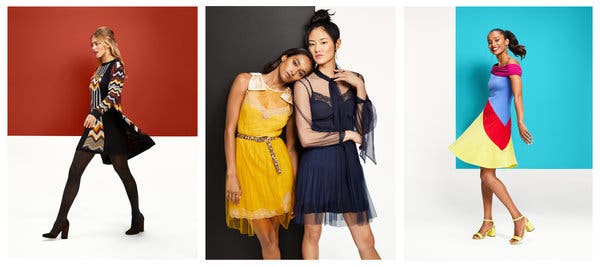In the late 1990s, when Target asked Isaac Mizrahi to create an affordable fashion line for its stores across the country, Mr. Mizrahi balked.
“It was a very scary thing,” the designer recalled. “Halston was my idol at the time, and he had failed,” he said of the notoriously ill-fated partnership between the American couturier and J.C. Penney more than a decade earlier.
But Mr. Mizrahi swallowed his misgivings long enough to whip up a collection of buttery coats, crisp blazers and colorful dresses that would become the first in a series of Target’s democratically conceived Design for All fashion collaborations.
That program — its subsequent partnerships included Missoni, Anna Sui, Alexander McQueen, Jason Wu, Zac Posen, Stephen Burrows, Rodarte and their sought-after like — was, in a sense, the granddaddy of the modern drop.
The parallels are striking. Target’s product releases, most with a housefly’s life span, stoked the kind of get-it-while-you-can acquisitive frenzy that has been mirrored more recently at Supreme and Adidas and other street wear brands.
Lines formed outside Target stores and, in at least one instance, the company’s website crashed. Sold out within days or even hours, those wares were snapped up for resale on eBay at prices inaccessible to the very shoppers Target initially hoped to lure.
John Zolidis, an analyst with Quo Vadis Capital, a research and investment firm, recalled the chaotic scene that followed the company’s 2011 Missoni collaboration. “I remember walking into the store and seeing the product sold out completely,” Mr. Zolidis said. “The fixtures were ravaged by the customers, and people were complaining online that they didn’t get to buy. In some ways, it was considered a debacle.”
In retrospect, it was a smash, earning the store the affectionate sobriquet Tar-Jay and spawning similar pop-up partnerships at H&M, Kohl’s and other mass-market chains.
Street wear, for its part, has stepped up the pace, its drops occurring weekly, not annually or seasonally, and focused on goods with a shelf life of no more than a day, and prices that could strain the most lavish budget. To compare Target’s program with contemporary drops may seem a stretch.
“But the fact that we are talking about it in the context of Supreme shows that Target is doing something right,” Mr. Zolidis said. “If you’re a big box store selling groceries and diapers, and you can bring people in for designer goods at low prices in a limited-edition environment, that’s a coup.”
Now Target is angling to repeat that success. On Sept. 14, the company will reissue 300 pieces from those original collaborations in a splashy Design for All 20th-anniversary celebration.
That announcement, I confess, lit a fire under me. Within hours, I was hustling to my storage unit, tearing through the racks and ripping open boxes to unearth the Missoni tank top I’d snapped up the first time around, and, along with it, a muted, floral-pattern Thakoon coatdress — still timely, still cool, I could hope.
Will other shoppers share that impulse? Hard to say. Target’s success, now as it was the first time around, will be largely a matter of timing.
A couple of decades ago, when the company announced its original collaborations, the moment was ripe. Mr. Mizrahi recalled glancing out the window of Da Silvano, then a Greenwich Village magnet for high-profile diners. “Up rolled a big Ford S.U.V. and out came the Miller sisters,” he said.

That the duty-free heiresses, the cream of young society, were climbing out of an S.U.V., not a Mercedes limousine, was a tell. “It signaled a cultural sea change,” Mr. Mizrahi said. “Now it was cool to drive around town in an S.U.V. and pick up fashion trophies at a big box store.”
Target’s initiative conferred cool on designers as well, shifting the perception that they were too fancy or too haughty to care about their less affluent fans. It also made hash of old rules.
“Back in the day, there were really defined parameters of what a designer could or could not do in terms of pricing,” Jason Wu said.
But Target broke the mold. “Selling fashion at affordable prices became acceptable, especially in the eyes of the fashion world, which can be rather closed off at times,” he said. “Suddenly selling to a mass audience became something we all wanted to do. There was a kind of prestige in it.”
Now, though, at a moment when high fashion-mass retail collaborations of the type pioneered by Target have lost steam, with artists and athletes supplanting designers in newer retail relationships — think Kaws and Roger Federer at Uniqlo — Target’s high-low revival may seem counterintuitive. The company is betting, nonetheless, that its cheap and chic concept still has legs, clearly hoping its throwbacks will mine a vein of consumer sentimentality.
“People still remember Missoni, all the hype and the excitement of that collaboration,” said Rick Gomez, the chief marketing officer of Target. “We are tapping into all those great nostalgic feelings.”
From time to time, Mr. Wu is tickled to spy one of his Target originals being worn around town. “Just the other day I saw a young woman walking in TriBeCa in my pink dress with a black collar and yellow, black and white stripes,” he said. “It was inspiring. It brought back a great time.”







